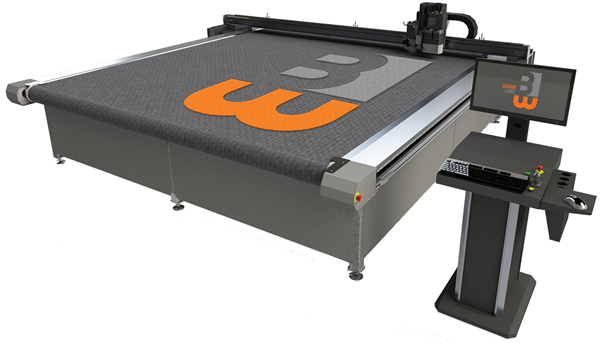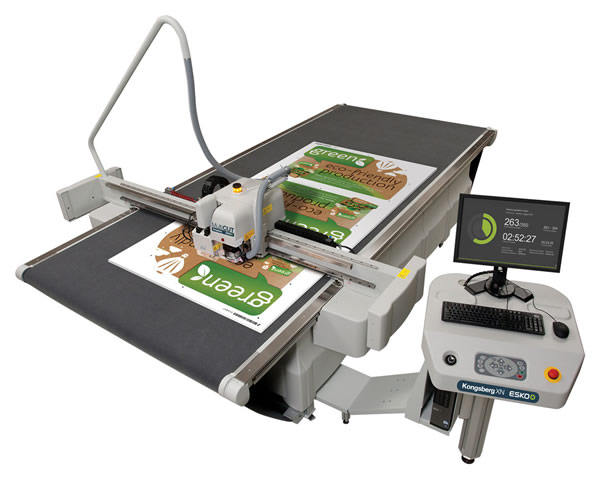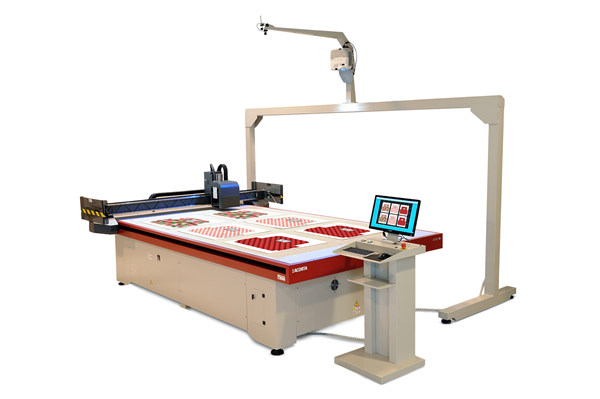The latest developments in automated cutting tables point toward a demand for faster throughput and better quality finishing as Nessan Clearly reports.
It's generally acknowledged that automated cutting tables are an essential rather than luxury accessory for flatbed printers. The trend when it comes to those flatbeds is for bigger and faster machines, which in turn means that it's even more important to get the work through the finishing stage as quickly as possible. Thus Peter Giddings, sales director at Zund UK, says that people are looking for more than just cutting capability, adding: “They want to see how the machine fits into the workflow.”
So, it’s no surprise that we're seeing a renewed emphasis on workflow centred around these cutting tables. There are three main ways to get cutting data to a table. The most basic is to produce a cutting path from a program like Adobe Illustrator and then export this but most wide-format users are beyond this or certainly should be. A better method is to integrate the cutter with the Rip. Giddings says that a few years ago only the major Rips like Onyx and Fiery would be able to do this but that now many Rips can integrate with the Zund cutters. We can reasonably expect to see more of this capability as it adds value to both the printers and the tables.
Most vendors of cutting tables have also produced their own software. Zund, for example, has developed Prepare It, which Giddings says is becoming more popular. It takes care of all the file handling, can produce cutting paths and set up for panels and tiles. It can also generate QR and barcodes, which is an increasingly common method of passing job information to finishing equipment. Giddings explains: “So all the elements of a job are loaded to the machine so we know the materials used and the number of tools required.”
Esko has also addressed the issue of automation in its Kongsberg tables by developing a new front-end control station. The iCut Production Console can control all the features found on the Kongsberg tales such as camera control, machine set up, tool recognition, calibration and tool adjustments. It has an icon-based graphical interface with colour-coded alerts and updates so that operators can work on other tasks while overseeing the production on the table. They can also pause a run, complete an urgent job or quick prototype, and return to the first batch of work for more efficient working. Stuart Fox, director of digital finishing at Esko, says: “There is a lot more integration to come because that's where we can deliver real value.”
He also points out that Esko can offer customers its Automation Engine workflow. This can be set up to automate a workflow so that it could open emails and automatically create PDFs and send them to a smartphone before printing a job. Fox adds: “If you can use it to drive the tables 30% more efficiently then that also applies to other devices.”
Agfa has also launched its own branded Acorta HS cutting tables, where the main advantage is the integration with Agfa’s Asanti workflow. Thus as well as Riping a file for printing, it can also send a copy of the image file plus a second file with the cutting paths to the Acorta. Philip Van der Auwera, product manager for the Acorta range, explains: “As soon as the print lands on the bed of the Acorta the camera recognises the image and automatically loads the corresponding cutting file.” It has an auto recognition system that can automatically locate the printed objects and the position of the reference points on the cutting table, as well as the substrate’s height so that there’s no need to manually set-up the job parameters.

Van der Auwera says that it’s important to Agfa to be able to offer a complete solution from printing to finishing. Thus Agfa has partnered with Elitron to rebadged its Kombo SD+ series to create the Acorta line. For now the Acorta uses the Elitron camera software but Van der Auwera says that Agfa is writing its own version.
It's a rack driven system that gives it a great deal of accuracy. It’s also capable of accelerating and stopping very quickly. Van der Auwera explains: “This accuracy means that we don’t need to cut too deeply.” He adds: “Sometimes to make a turn the speed of the knife needs to slow down so that it doesn’t cut too deep but we avoid this by using a rack drive.”
There are two sizes, which Agfa says will match to specific printers. Thus the 3120 has a bed of 3.1 x 2m and can be paired with the Anapurna 2500i and Titan HD, while the 2016 measures 2x1.6m and matches the Anapurna 2050i. Both can cut at up to 102 m/min.
However, it’s worth noting that Atech sells the complete Elitron series. This includes the Kombo SDC, which is essentially a version of the Kombo SD with a conveyor belt. There’s also a Kombo T for handling more industrial materials like stainless steel and copper, and a smaller, cheaper model, the Kombo EL.
Materials handling
Another issue is the range of materials that these tables can handle and the cutting tools available. Fox argues that as wide-format service providers look at different materials so the table manufacturers have to adapt to handle these requirements, noting: “It's the materials like Rebord and Dibond that add value to the jobs.”
Traditionally, cutting tables have used knifes for very fine, accurate contour cutting of lightweight materials, while routers have been a better option for more heavy-duty materials. But in recent years we've seen a number of routers appear with knife tools that are capable of very accurate cutting. Giddings says that Zund will improve its router capability shortly to redress this balance.
In the meantime, Zund has recently re-engineered its G3 cutting tables to double the beam height to 120mm. As a result the L-3200 and XL-3200 models are now able to accommodate thicker materials up to 110mm such as corrugated cardboard, solid cardboard, foam, sandwich material and corrugated plastic.
But we are also seeing vendors that have specialised in more industrial uses now targeting the sign and display market. Thus Blackman and White has developed a new cutting table, the Versa-Tech specifically for wide-format use. This is a 3.2m wide table that’s aimed at the more heavy-duty end of the market. It uses a 2.5kW water-cooled router for sustained production runs on heavy-duty materials such as acrylics and Dibond. It can be configured with a single conveyorised or flatbed heavy-duty table and runs on a linear rack in order to maintain accuracy over time.
There’s a choice of tools, including crease, kiss cut, router, drag knife, oscillating knife and driven rotary knife. It allows for dual driven tooling with interchangeable ‘drop-in’ tools, with both an oscillating head and driven wheel to quickly change between different cutting types.
There is clearly a move toward bigger tables capable of handling heavier materials. But there is also a consensus that there's a need for more efficient workflow to enable faster production. Interestingly, in recent years we’ve seen a number of budget cutting tables from all vendors but now most suppliers agree that people are mainly looking for high quality results rather than lower prices. This matches a recent trend in flatbed printers, towards bigger, faster machines without any compromise in image quality.


